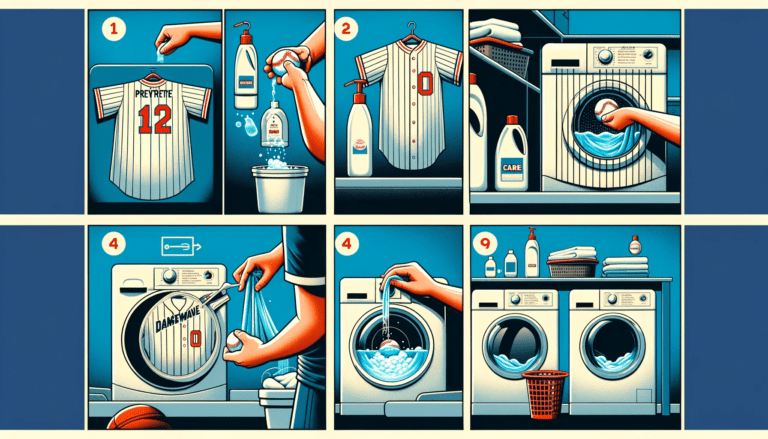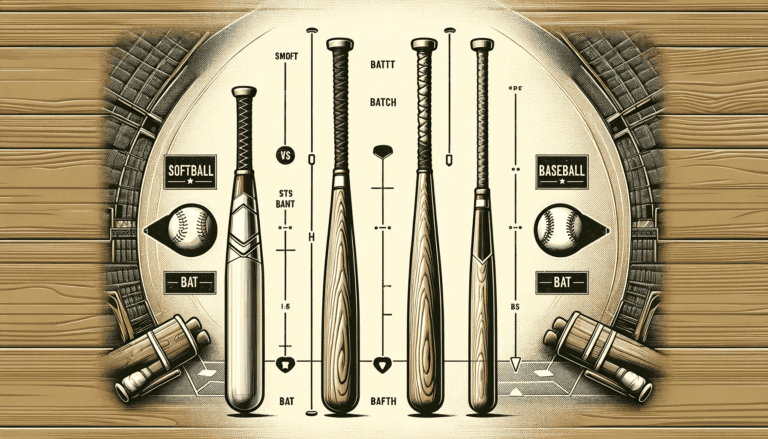How to Properly Swing a Baseball Bat?
Swinging a baseball bat correctly is crucial for hitting the ball with power and accuracy. Many players struggle with proper technique, resulting in weak hits or missed swings.
Improper swing mechanics can lead to frustration, poor performance, and even injuries. Watching professional players make it look effortless can be discouraging if you’re unsure of the correct technique.
This article will guide you through the essential steps to swing a baseball bat properly. By following these simple instructions, you’ll develop a solid swing foundation, increasing your chances of making solid contact with the ball and driving it with authority.
By the end, you’ll know exactly how to enhance your batting skills and hit the ball with more precision and more power throughout.
Key Takeaways
- Proper swing mechanics can be honed with the use of specialized training bats that provide immediate feedback on the swing path.
- Selecting the right training tools, including weighted bats and adjustable tees, is crucial for developing muscle memory for the perfect swing.
- Consistent practice with visual and audible feedback tools helps in analyzing and correcting the swing path effectively.
- Advanced training techniques, such as kinematic swing analysis, can fine-tune a player’s swing to match professional standards.
- Maintaining and improving your swing requires daily practice routines and staying updated with the latest hitting instruction trends.
Understanding Swing Mechanics

The Importance of Swing Path
Mastering the swing path is crucial for any baseball or softball player aiming to hit with power and precision.
A proper swing path ensures that the bat meets the ball most efficiently, maximizing the bat strikes potential for solid contact and driving the ball with force.
Here are some key aspects to consider:
- The swing path must be both linear and rotational, allowing hitters to generate power through their hips and spine.
- Repetition is key to developing the muscle memory required for a consistent swing path.
- Training tools like the Swing Path Trainer can provide immediate feedback, ensuring that the swing mechanics are correct.
By focusing on the swing path, players can refine their technique to achieve a more effective and powerful swing.
It’s not just about strength; it’s about the precision of movement and the ability to replicate it consistently.
Developing Muscle Memory for the Perfect Swing
Developing muscle memory is crucial for mastering the perfect swing in baseball. The Swing Path Trainer is a tool designed to ingrain the correct swing path and bat angle through the hitting zone, which is essential for consistent performance.
By forcing hitters to adopt the correct mechanics, it ensures that each repetition contributes to the development of a flawless swing.
To effectively develop muscle memory, consider the following steps:
- Adjust the height and angle of the training tee to match your specific needs.
- Practice your swing repeatedly, focusing on maintaining the correct form.
- Gradually increase the speed of your swings while preserving the proper mechanics.
- Use visual and audible feedback to refine your swing path and make necessary adjustments.
Remember, the goal is not just to strengthen your back leg, and speed up your swing, but to teach your muscles the motion of a perfect swing.
With consistent practice using the right tools, like The Swing Path Trainer, players can see a noticeable improvement in their swing during actual games.
The Role of Training Bats in Enhancing Mechanics
Training bats are essential tools for honing the intricacies of a batter’s swing. By focusing on the swing path, these specialized bats provide immediate feedback, allowing hitters to adjust and perfect their technique in real time.
For instance, bats like the ProVelocity Bat and the Insider Bat are designed to emphasize the importance of a correct swing path.
Incorporating a variety of training bats into practice sessions not only keeps the training engaging but also addresses different aspects of the swing.
This approach can be particularly useful for breaking through hitting slumps or for working on increasing bat speed and power.
The Tanner Tees collection offers a range of training bats suitable for all ages and skill levels, ensuring that every player has the opportunity to improve.
To maximize the benefits of training bats, it’s important to challenge the hitter’s abilities. As proper mechanics are established and the lower half of the whole upper body) is engaged, players can increase the force required to activate the trainer, thereby enhancing their swing strength without compromising their health.
Read Also: Can You Hit Baseballs with a Softball Bat
Selecting the Right Training Tools

Evaluating Different Types of Swing Trainers
Selecting the right swing trainer is crucial for developing a consistent and powerful batting technique.
The Swing Trainer Select is a versatile tool that allows for adjustable ball heights, simulating various hitting zones for targeted practice. Its two-piece design ensures easy transport and quick setup, making it ideal for both field and home use.
When considering swing trainers, it’s important to look beyond basic models that focus solely on strength and aim.
For instance, The Swing Path Trainer revolutionizes the way batters train by enforcing correct swing paths and bat angles, which are essential for hitting accuracy across all pitch locations.
Here are some factors to consider when evaluating swing trainers:
- The ability to adjust for different pitch locations.
- Whether the trainer promotes correct swing mechanics and muscle memory.
- The convenience of setup and portability for regular use.
- The trainer’s design and how it absorbs impact to provide stability during use.
Remember, the best swing trainer is one that not only improves ball contact and hitting technique but also integrates seamlessly into your practice routine, whether on the field or at home.
Incorporating Weighted Bats and Bat Weights
Integrating weighted bats and bat weights into your training regimen can be a game-changer for developing both power and speed in your swing.
Weighted training tools are designed to enhance strength and improve bat speed, which are critical components for hitting the ball with more force.
Players often experiment with different bat weights to find the optimal balance that feels comfortable and maximizes their performance.
When using weighted bats, such as the CamWood Hands and Speed Trainer, hitters can work on correcting common mechanical issues like the casting effect.
These specialized bats have a built-in weighted knob that helps maintain proper swing mechanics while also building muscle.
Similarly, bat weights like the Hitting Knob Bat Weight can be easily attached to the knob of your favorite bat, allowing for versatile training sessions.
Here are some key benefits of incorporating these tools into your practice:
- They help in building muscle strength specific to hitting.
- They can improve swing mechanics and reduce common errors.
- They allow for a seamless transition from training to game situations.
Remember, the goal is to find a training weight that challenges you without compromising your swing technique.
As you progress, you can gradually increase the weight to continue building strength and enhancing your swing.
The Benefits of Using an Adjustable Tee and Guide Board System
Integrating an adjustable tee and guide board system into your training regimen can be a game-changer for hitters looking to refine their swing.
By adjusting the height and angle of the board, players can practice hitting from various angles, which is essential for developing a versatile and powerful swing.
This adaptability is crucial for both baseball and softball players, as it caters to the unique demands of each sport.
The benefits of such a system are manifold:
- It promotes the development of strong muscle memory, leading to a more consistent and perfect swing.
- The adjustability allows for zone-specific work, enabling hitters to focus on inside and outside pitches.
- The guideboard can correct common swing deficiencies, such as casting, by providing immediate feedback.
Moreover, the durability of the equipment, like the Swing Path Trainer, ensures that it can withstand the rigors of frequent practice.
The inclusion of features such as an adjustable guide bar and different tee toppers for various training exercises makes it a versatile tool in any hitter’s arsenal.
Read Also: How to Hold a Baseball Bat
Executing the Swing

The Basics: Stance, Stride, and Eye Coordination
Mastering the basics of a proper swing in baseball is crucial for consistent performance at the plate.
A well-executed swing begins with the front foot down with a solid stance; feet should be shoulder-width apart, knees slightly bent, and weight evenly distributed.
The stride, a small step back foot, towards the pitcher, sets the motion for a powerful swing while maintaining balance.
Eye coordination is essential as it allows the hitter to track the ball from the bat point to the pitcher’s release to the point of contact.
Here are some key steps to enhance your own hand eye coordination:
- Focus on the pitcher’s release point to anticipate the ball’s trajectory.
- Practice tracking the ball by hitting off a tee, which can improve hand-eye coordination.
- Switch your gaze from a fixed point, such as a pretend pitcher, to the ball as you initiate the swing.
Repetition is the mother of skill, and incorporating these elements into daily practice will lead to a more effective and consistent swing.
Remember, the goal is to create a swing that is both powerful and controlled, allowing for good contact with the ball regularly.
Repetition and Practice: Building Consistency
Consistency in your golf swing is not just about hitting the ball; it’s about hitting it correctly, time after time.
Repetition is the mother of skill, and nowhere is this truer than in baseball. By repeating the correct swing mechanics, you engrain them into your muscle memory, making each swing more natural and more effective.
To build this consistency, consider the following steps:
- Start with a proper batting stance and eye coordination, ensuring you’re in the best position to hit the ball.
- Practice your swing with hundreds of repetitions, focusing on the quality of each swing rather than the quantity.
- Use tools like the Tempo Trainer and mini tee topper to provide tactile feedback and promote steady eyes on the pitch.
Remember, the goal is to develop good habits and erase old ones. This means taking the time to analyze each swing, making sure you’re not getting on top of the ball or dropping your barrel through the zone.
With dedicated practice, you’ll see improvements, turning those ground balls into line drives and fly balls.
Analyzing and Correcting Swing Path with Visual and Audible Feedback
To effectively analyze and correct your swing path, incorporating visual and audible feedback tools can be transformative. These tools provide immediate insights into the quality of each swing, allowing hitters to make adjustments on the fly.
For instance, the use of a Swing Analyzer (sensor) can offer real-time feedback that is crucial for refining swing mechanics.
By attaching this device to the knob of any bat, the hitter can receive automatic updates on their performance.
Key to this process is the selection of appropriate training bats that emphasize swing path and mechanics.
Bats like the ProVelocity Bat and the Insider Bat are designed to provide feedback that helps the hitter understand when their swing is correct.
This immediate feedback loop is essential for developing the muscle memory required for a consistent and powerful swing.
Remember, the goal is not just to hit the ball but to do so with optimal force and accuracy. Regular practice with these feedback tools can lead to significant improvements in your swing path, ultimately enhancing your overall hitting performance.
Advanced Training Techniques

Utilizing Specialty Training Bats for Specific Skills
Specialty training bats are essential tools for honing specific aspects of a batter’s swing. Using a training bat can significantly improve swing mechanics by focusing on elements such as swing path, speed, and power.
For instance, bats like the ProVelocity Bat and the Sequence Trainer Bat are designed to provide immediate feedback, allowing hitters to adjust their swing in real time.
- The Insider Bat emphasizes swing path correctness, offering visual or audible cues to the hitter.
- Bats like the CamWood Hands and Speed bat aim to increase swing speed while maintaining proper mechanics.
- The RopeBat helps hitters utilize centrifugal force to connect and perfect their swing.
Tanner Tees offers a variety of these specialized bats, catering to both baseball and softball players.
Incorporating these bats into your training regimen can lead to more effective batting practice sessions, helping to break out of slumps and build strength.
The Science Behind Kinematic Swing Analysis
Kinematic swing analysis is a sophisticated approach to understanding the phases of a baseball swing.
By breaking down the swing into its constituent parts, coaches and players can identify specific areas for improvement.
This analysis often involves the following steps:
- Capturing the swing using high-speed cameras or motion capture technology.
- Analyzing the data to determine the kinematics of the swing, such as angles, velocities, and timing.
- Comparing the results to ideal swing models or previous swings of the player to identify deviations.
The insights gained from kinematic analysis can lead to targeted training interventions. For instance, if a player’s swing shows a tendency to drop the front shoulder down, drills can be designed to correct this.
Moreover, the adaptive response to cognitive challenges during a game can be better understood through this analysis, allowing players to adjust their mechanics under pressure.
Ultimately, kinematic swing analysis provides a scientific basis for enhancing swing mechanics and overall performance.
Customizing Drills for Different Skill Levels
Customizing drills to cater to the varying skill levels of players is essential for effective training. Beginners should focus on mastering the fundamentals, such as proper stance and swing mechanics, before progressing to more complex exercises.
For intermediate players, drills that challenge their current abilities, like the ‘Rapid Fire Drill’, can be particularly beneficial in pushing their limits.
Advanced players, on the other hand, may benefit from drills that provide instant feedback, such as those that address specific issues like ‘Stop Rolling Your Hands at Contact’. These drills help refine their swing path and encourage adaptability to different pitch speeds.
It’s important to incorporate drills that simulate game-like conditions, such as the ‘3 Plate Drill’, to prepare players for real-game scenarios.
- Master fundamentals: stance, swing mechanics
- Intermediate challenges: ‘Rapid Fire Drill’
- Advanced feedback: ‘Stop Rolling Your Hands at Contact’
- Game-like conditions: ‘3 Plate Drill’
By tailoring drills to individual needs, players can continue to develop their skills effectively, ensuring that they are always ready to perform their best when the game is on the line.
Maintaining and Improving Your Swing Over Time

Daily Practice Routines for Muscle Memory
To maintain and improve your swing, it’s essential to establish daily practice routines that focus on reinforcing muscle memory.
These routines should include a variety of drills that target different aspects of your swing mechanics.
For instance, the ‘palm up, palm back shoulder and down through extension’ drill, often referred to as the ‘hockey drill’, is excellent for developing power through the extension phase of your swing.
Incorporate drills such as the ‘rapid fire drill’ to enhance your performance under pressure, and exercises like ‘stopping rolling your hands at contact’ to correct common batting errors.
It’s also beneficial to use tools like a 7×7 net for immediate feedback, allowing you to spot and correct problems quickly.
Remember to monitor your progress regularly to ensure that the drills are effectively contributing to your swing development.
Lastly, repetition is key. Aim for a high number of repetitions within a short time frame, such as hitting the ball multiple times every five minutes.
This not only builds muscle memory but also allows for faster improvement and the ability to self-correct without constant supervision.
Over time, these practices will help you develop good habits and phase out any detrimental ones, leading to a more controlled and powerful swing.
Adjusting Training as Skills Evolve
As players progress, it’s crucial to adapt training methods to match their evolving skills. This ensures continuous improvement and prevents plateaus in development.
Here are some steps to consider:
- Regularly assess your current abilities and set new, challenging goals.
- Introduce advanced training tools and techniques to refine specific aspects of your swing.
- Seek feedback from coaches and use technology for detailed swing analysis.
Incorporating these adjustments can lead to improved bat speed and timing, essential for success on the field.
Remember, as your skills grow, so should the complexity and intensity of your training regimen. This dynamic approach keeps players healthy and prepared to face tougher competition.
Staying Informed on the Latest Hitting Instruction Trends
To maintain a competitive edge, it’s crucial to stay abreast of the latest hitting instruction trends.
Engaging with new training methodologies can lead to significant improvements in your swing.
Here are a few ways to keep your knowledge current:
- Subscribe to reputable baseball training blogs and magazines.
- Attend workshops and clinics hosted by professional hitting coaches.
- Network with other players and coaches to exchange tips and experiences.
By incorporating fresh insights and techniques into your practice, you can ensure that your training remains effective and your skills continue to evolve.
Remember, the landscape of baseball training is always changing, with new tools and methods emerging regularly.
For instance, the rise of programmable pitching machines is a testament to the ongoing innovation in the sport played baseball. Look at these advancements and use them to refine your swing and overall approach to hitting.
Conclusion
In conclusion, getting better at swinging a baseball bat is all about using the right gear, putting it into practice, and understanding how to swing right.
In this article, we talked about different things you can use to help, like training bats such as the ProVelocity Bat and the Insider Bat, and also something cool called the Swing Path Trainer.
This thing is great for helping you remember how to swing perfectly every time. Whether you’re just starting or you’ve been playing for a while, using these helpers can really make your batting better.
Remember, swinging the bat well isn’t just about how strong or fast you are. It’s about how precise and consistent you are with your swing.
Keep at it, don’t rush, and use the tips we’ve shared to help you become an awesome hitter.
Frequently Asked Questions
What are the benefits of using a training bat?
Using a training bat or practice bats helps hitters and coaches work on the fundamentals of good swing mechanics by emphasizing specific elements. They provide visual or audible feedback for immediate correction, ensuring the swing path is correct.
How does the Swing Path Trainer differ from other swing trainers?
The Swing Path Trainer is the first batting tee that forces hitters to have the correct swing path and bat angle through the hitting zone at all pitch locations, helping develop muscle memory for a perfect swing.
Can the Swing Path Trainer be used for both baseball and softball?
Yes, the Swing Path Trainer is perfect for both softball and baseball as it is easily adjustable and designed to be used with both types of balls.
Why is repetition important in practicing batting?
Repetition is crucial for building consistency and developing muscle memory. It allows hitters to refine their stance, contact, and swing until they achieve the desired level of proficiency.
What is kinematic swing analysis and why is it important?
Kinematic swing analysis is the scientific study of the mechanics of body movements during a baseball swing. It’s important because it helps in building a swing that can withstand the scrutiny of elite level play.
How does an adjustable tee and guideboard system improve a batter’s swing?
An adjustable tee and guide board system allows hitters to practice hitting from various angles, creating strong muscle memory for the perfect swing at any ball angle.







